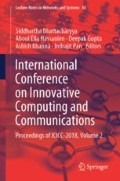Abstract
A government policy is an ideology of principles, ethics, regulations, and set of rules introduced or constituted by government in interest of normal citizens across country. The purpose of making a policy or scheme is to explore and strengthen the favourable outcomes or profits and to minimize the adverse effects noticed by government. On the flip side, all the government policies are destined to be efficacious but on the contrary may affect the routine life of a common man. An efficient and endless process of policy evaluation may leads to accurate assessment of progress graph or outcomes of policy in order to improve the social and economic conditions of different stakeholders. The aim of this paper is to evaluate one of the recent government policy, Pradhan Mantri Sahaj Bijli Har Ghar Yojana, or Saubhagya initiated by Indian government to accomplish global electrification across country. In this paper, an attempt has been made to analyse the public perception of this scheme by using opinion mining techniques to understand the positive and negative impact of this policy over Indian citizen. Twitter as a social media tool has been used for collecting and extracting public opinion or sentiments over this scheme.
Access this chapter
Tax calculation will be finalised at checkout
Purchases are for personal use only
References
Kumar A, Sharma A (2016) Paradigm shifts from e-governance to s-governance. The human element of big data: issues, analytics, and performance. p 213
National e-Governance Plan. http://www.mit.gov.in/content/national-e-governance-plan
Digital India. http://www.cmai.asia/digitalindia/
National e-Governance Plan. http://meity.gov.in/divisions/national-e-governance-plan
Bhatia MPS, Kumar A (2010) Paradigm shifts: from pre-web information systems to recent web-based contextual information retrieval. Webology 7(1)
Bhatia MPS, Khalid AK (2008) A primer on the web information retrieval paradigm. J Theor Appl Inf Technol 4(7)
Saubhagya scheme. All you need to know. http://www.livemint.com/Industry/6agWD5oCYBi6jokfKc3QjP/Saubhagya-scheme-All-you-need-to-know.html
Kumar A, Sebastian TM (2012) Sentiment analysis on twitter. IJCSI Int J Comput Sci Issues 9(4):372
Press Information Bureau, Government of India, Ministry of Power. http://pib.nic.in/newsite/PrintRelease.aspx?relid=171148
Dayal D, Gram U, Yojana J. https://en.wikipedia.org/wiki/Deen_Dayal_Upadhyaya_Gram_Jyoti_Yojana
Integrated Power Development Scheme. A priority programme of Govt of India. http://www.ipds.gov.in/Form_IPDS/About_IPDS.aspx
Press Information Bureau, Government of India, Ministry of Power. http://pib.nic.in/newsite/PrintRelease.aspx?relid=123595
Press Information Bureau, Government of India, Cabinet. http://pib.nic.in/newsite/PrintRelease.aspx?relid=111621
What is Saubhagya Yojana. http://indianexpress.com/article/what-is/what-is-saubhagya-yojana-pradhan-mantri-sahaj-bijli-har-ghar-yojana-4860947/
Saubhagya Scheme: Features, Benefits and Challenges. http://www.jagranjosh.com/current-affairs/saubhagya-scheme-features-benefits-and-challenges-1507620376-1
Kumar A, Jaiswal A (2017) Empirical study of twitter and tumblr for sentiment analysis using soft computing techniques. In: Proceedings of the world congress on engineering and computer science vol 1
Naive Bayes classifier. https://en.wikipedia.org/wiki/Naive_Bayes_classifier
Support vector machine. https://en.wikipedia.org/wiki/Support_vector_machine
Multilayer perceptron. https://en.wikipedia.org/wiki/Multilayer_perceptron
K-nearest neighbour algorithms. https://en.wikipedia.org/wiki/K-nearest_neighbors_algorithm
What is a Decision Tree Diagram. https://www.lucidchart.com/pages/decision-tree
Amolik A, Jivane N, Bhandari M, Venkatesan M (2016) Twitter sentiment analysis of movie reviews using machine learning techniques. Int J Eng Technol 7(6):1–7
Kumar A, Teeja MS (2012) Sentiment analysis: a perspective on its past, present and future. Int J Intell Syst Appl 4(10):1
Author information
Authors and Affiliations
Corresponding author
Editor information
Editors and Affiliations
Rights and permissions
Copyright information
© 2019 Springer Nature Singapore Pte Ltd.
About this paper
Cite this paper
Kumar, A., Sharma, A. (2019). Opinion Mining of Saubhagya Yojna for Digital India. In: Bhattacharyya, S., Hassanien, A., Gupta, D., Khanna, A., Pan, I. (eds) International Conference on Innovative Computing and Communications. Lecture Notes in Networks and Systems, vol 56. Springer, Singapore. https://doi.org/10.1007/978-981-13-2354-6_40
Download citation
DOI: https://doi.org/10.1007/978-981-13-2354-6_40
Published:
Publisher Name: Springer, Singapore
Print ISBN: 978-981-13-2353-9
Online ISBN: 978-981-13-2354-6
eBook Packages: Intelligent Technologies and RoboticsIntelligent Technologies and Robotics (R0)

